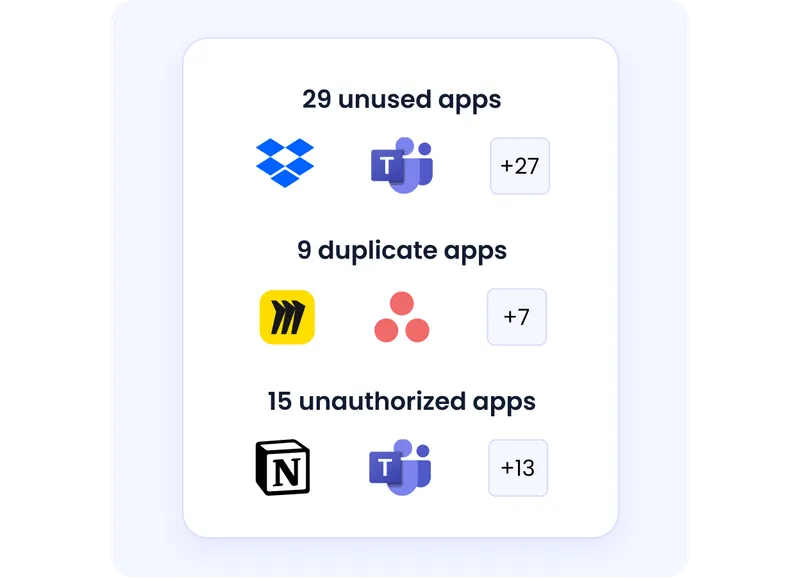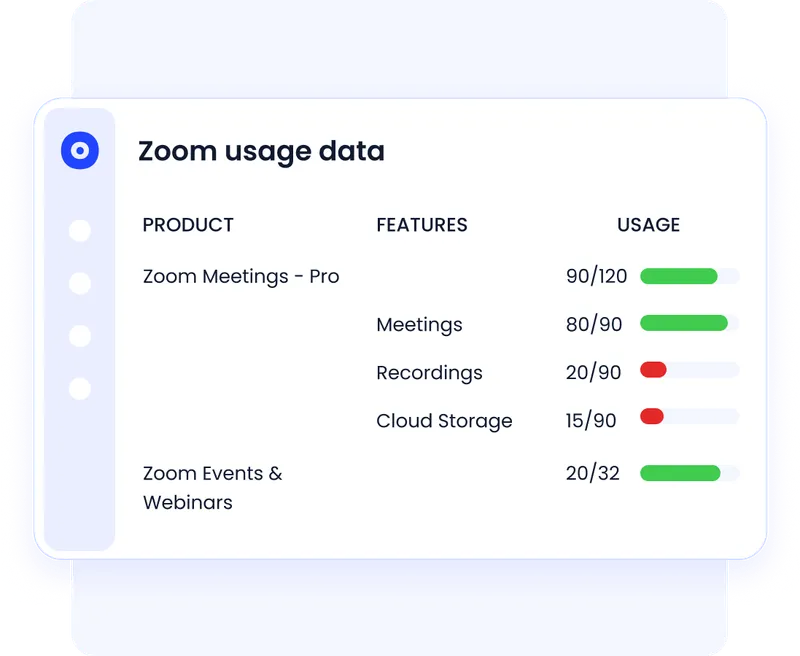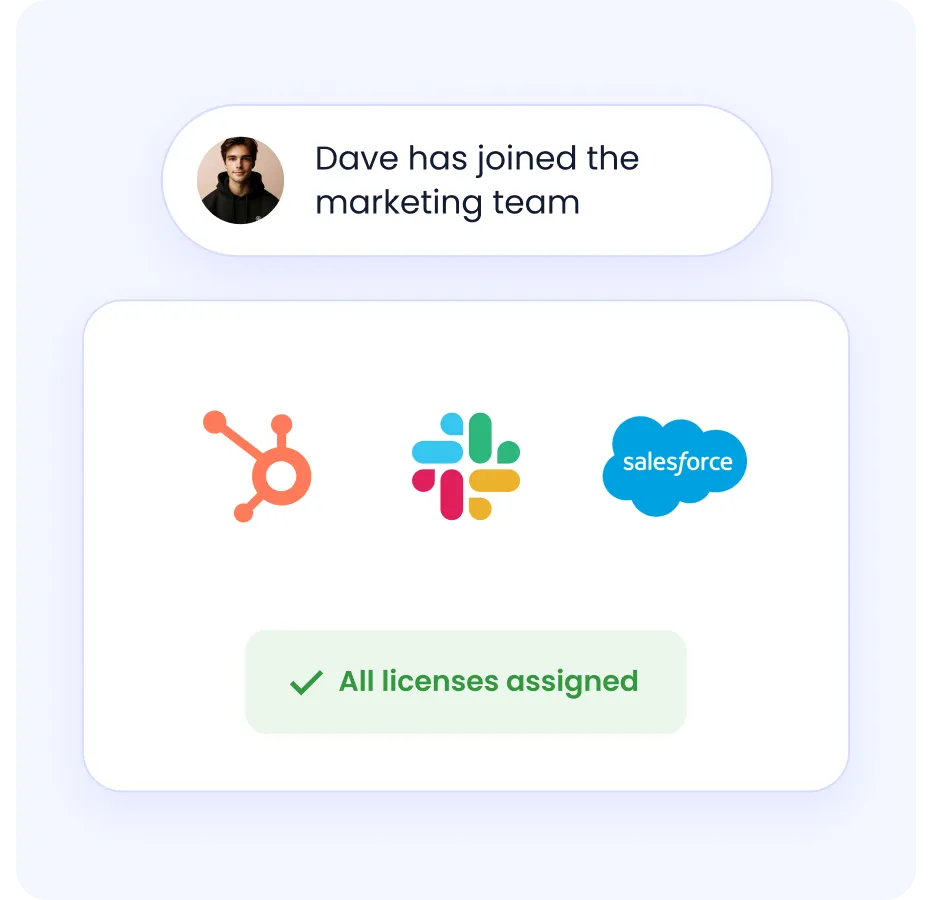HIPAA Compliance Checklist for 2025

Have you ever felt overwhelmed managing SaaS apps in one place, struggling to keep up with everything at once?
You're not alone. IT teams have to deal with many SaaS apps daily, including duplications and redundancies, making optimizing overall SaaS stack management challenging.
According to reports, 53% of SaaS licenses remain unused in organizations. However, you can effectively optimize the SaaS stack using the SaaS application rationalization framework.
The application rationalization framework is an iterative approach designed to enhance your organization's operational efficiency. It is like cleaning up and organizing a cluttered closet of SaaS applications.
The process includes readiness assessment and analyzing which applications are a technical fit, align with business goals, and are worth keeping.
The steps are simple:
- Make a list of all applications. Analyze the usage and see how it contributes to your business.
- Check if each application helps with the organization's goals. If not, consider if it's still needed.
- Look at the costs of maintaining each application, including licenses and maintenance. Decide which ones are worth the cost.
- Consolidate similar applications or remove those that aren't useful anymore. It simplifies things and cuts down on costs.
You must do this to keep your organization's digital space tidy, save money, work more efficiently, and be more flexible.
Keep reading this article to learn and build your application rationalization framework to enhance your organization's operational efficiency. This article provides practical tips and insights to simplify your software choices.
What is Application Rationalization?
Application rationalization is the practice of reviewing and optimizing your entire software portfolio to decide which applications to retain, retire, replace, or consolidate.
Think of it as a health check for your IT ecosystem: the goal is to cut out redundancies, lower costs, and make sure every application adds real business value.
Instead of letting unused or overlapping tools drain your budget, application rationalization creates a streamlined application portfolio that aligns with business priorities. The result? Lower spend, stronger security, and resources freed up for innovation.
At its core, application rationalization goes beyond IT cleanup, it’s a strategic framework for evaluating the value of each application against the organization’s goals.
When done right, it gives decision-makers clarity on which tools drive efficiency and which ones need to go, paving the way for long-term growth.
What are the Benefits of Application Rationalization?
Application rationalization involves organizing and removing redundant, low business-value software applications used throughout your organization. You can eliminate SaaS sprawl and optimize your SaaS portfolio using this framework.
It enhances your enterprise architecture, reduces the costs associated with owning and managing applications, and makes way for better innovation.
The goal is to boost efficiency by eliminating unnecessary tools and saving money. It's not just about cutting costs; it's one of the smart methodologies to make your portfolio look optimized and your teams work better.
Here are some application rationalization benefits that shows why you shouldn’t overlook it:
Cost Efficiency: By rationalizing applications, you can identify and eliminate redundant or underutilized software. It leads to cost savings as you avoid unnecessary licensing fees, maintenance, and support costs.
Resource Optimization: It helps you improve IT resource allocation and vendor management. You can assign SaaS app licenses more effectively.
You can improve how you handle SaaS licenses by giving them to users who actually need them and using them correctly. This helps boost efficiency instead of having extra licenses for applications that aren't really needed or used.
Enhanced Productivity: Reducing the number of redundant applications streamlines workflows. Employees can concentrate on using and mastering a core set of tools rather than dealing with many applications with varying complexities.
Better Security: Managing a smaller stack of sanctioned applications makes implementing and monitoring security measures easier. Security vulnerabilities are easier to identify and address when dealing with a streamlined and standardized application stack.
Scalability and Agility: An optimized application portfolio makes it easier for organizations to scale and adapt to changing business needs. It facilitates the integration of new technologies and the deployment of updates and changes more efficiently.
What are the challenges of application rationalization?
Even with a well-defined application rationalization framework, execution isn’t simple. Organizations run into visibility issues, resistance from teams, and technical complexity that slows down progress. Successful IT application rationalization requires addressing these roadblocks head-on.
1. Visibility and Assessment Gaps
Many organizations lack a complete and accurate application inventory. Shadow IT and unsanctioned tools make it hard to spot redundancies or unused licenses. Without clear usage data, measuring the value of each application or calculating true ROI becomes guesswork.
2. Portfolio Complexity at Scale
A large application portfolio rationalization project can overwhelm IT teams. Applications are often interconnected with other systems, APIs, and databases, making it difficult to predict how retiring one tool will affect workflows across the business.
3. Resistance from Stakeholders
Teams often resist retiring or replacing familiar applications, fearing disruption or productivity dips. Without strong executive buy-in and clear communication of the benefits of application rationalization, these initiatives stall.
4. Security and Compliance Risks
Retiring applications isn’t just a technical switch-off. If data isn’t migrated or user access isn’t deprovisioned properly, organizations risk compliance violations and security vulnerabilities. This is where structured application rationalization tools are crucial.
5. Ongoing Optimization Needs
Application rationalization isn’t a one-time cleanup. Without a process for continuous monitoring, organizations quickly fall back into SaaS rationalization challenges: duplicate tools, underutilized licenses, and uncontrolled spend.
8-Step Application Rationalization Framework
With this 8-step application rationalization roadmap, you can target redundancies, cut costs, and boost the operational efficiency of your organization.
1. Get complete visibility into your SaaS portfolio

As the first step in the framework, you have to get complete SaaS app visibility in your SaaS stack. This visibility is important because many businesses use different apps, which can get messy.
Using usage data lets you make informed decisions on which apps to retain, modify, and optimize costs. It functions as a digital map, ensuring seamless integration and enhancing efficiency to contribute to your business's success.
2. Assess your SaaS inventory for redundant and unused apps
You can use a SaaS management platform to evaluate your SaaS inventory, explicitly looking for apps that might be redundant or unused. By assessing your SaaS stack, you can identify apps that might be doing similar things or aren't used much.
This application portfolio management process helps streamline your inventory applications, ensuring you only invest in tools that bring real value to your business.
It's a practical way to optimize your SaaS resources, cut unnecessary costs, and ensure that every digital tool you have contributes to your success, leading to an increased bottom line.
3. Establish evaluation criteria

While creating the application rationalization framework, you must specify guidelines to help you decide which SaaS apps are keepers.
Four key criteria are to consider:
- Business Value: This is about determining how much each app contributes to your business goals. Does it help you make more money, save time, or improve customer satisfaction? Apps that bring more value are like MVPs in your digital lineup.
- Functionality: Take a close look at what each app does. Does it perform its job well? Does it meet your business needs without being overly complicated? Functionality is all about making sure your tools work smoothly and efficiently.
- Risk: Consider the potential risks associated with each app. It involves looking at factors like data security and compliance. You want to ensure that using a particular app doesn't expose your business to unnecessary risks or vulnerabilities.
- Technical Quality: This criterion focuses on the technical side of things. Is the app reliable? Does it integrate well with your existing systems? Technical quality ensures that your digital tools work within your overall technology landscape.
4. Conduct total cost of ownership analysis for each application

Conducting a Total Cost of Ownership (TCO) analysis for each application is very important. It's not just about the upfront price; it's about considering all the costs of owning and using throughout the application lifecycle.
This analysis includes the initial purchase or subscription costs and factors in ongoing expenses such as maintenance, updates, training, and support. Additionally, hidden costs, like potential disruptions to productivity or increased cybersecurity measures, should be considered.
5. Ask for feedback and collect user satisfaction metrics
By actively seeking feedback and collecting satisfaction metrics for applications in their current state, you can ensure your SaaS portfolio aligns with user expectations and needs.
It involves reaching out to the people who use the software—your workforce and end-users—and finding out what they think. This feedback loop helps gauge users' satisfaction with their daily applications.
- Are the apps user-friendly?
- Do they meet specific needs?
Understanding user satisfaction metrics provides valuable insights into your team's practical, day-to-day experiences. This information determines whether an application genuinely adds value to your business operations.
6. Determine appropriate actions based on satisfaction metrics
Determining appropriate actions based on satisfaction metrics to make strategic decisions about each application in your portfolio.
Here are four key actions based on user satisfaction metrics:
Keep: Applications receiving positive feedback and high user satisfaction can be kept in your SaaS stack. These are the tools that are contributing effectively to your business operations, and users find them valuable.
Retire: If an application consistently receives low satisfaction metrics and is not meeting user needs or business requirements, it might be time to retire it. It involves discontinuing its use and finding alternative solutions that align with your organization's goals.
Replace: For applications with mixed feedback or those that are becoming outdated, consider replacing them with newer or more suitable alternatives. This action ensures that your digital tools remain current, efficient, and aligned with evolving business needs.
Consolidate: Sometimes, you may have multiple applications performing similar functions. If user feedback indicates redundancy, consider consolidating these tools. This action streamlines your digital portfolio, reducing complexity and potentially lowering costs.
7. Implementation, Communication, and Change Management
Implementing the application rationalization framework involves careful planning, effective communication, and strategic change management.
Here's a breakdown of each aspect:
Implementation: This phase involves implementing the rationalization plan. It includes identifying stakeholders, allocating resources, and executing the decisions made during the assessment phase.
It may involve retiring, replacing, consolidating, or keeping certain applications based on the established criteria.
Communication: You must regularly inform stakeholders, including end-users and decision-makers, about reasons for changes, rationalization benefits, and expected outcomes. Regular updates and feedback mechanisms ensure everyone is on the same page, reducing resistance to change.
This streamlined and open communication process is vital for building understanding and support.
Change Management: Change can be challenging, and effective change management is essential for a successful app rationalization initiative.
It involves anticipating and addressing concerns, providing training for new tools or processes, and creating a supportive environment for users to adapt to the changes.
8. Ongoing Monitoring and Governance
The application rationalization framework doesn't conclude with implementation; it extends into the critical phase of ongoing monitoring and governance to ensure sustained effectiveness.
Here's how this aspect is managed:
Ongoing Monitoring: Continuous monitoring is essential to track the performance and impact of rationalization decisions over time. It involves regularly assessing key metrics such as user satisfaction, application usage, and adherence to established criteria.
Governance: Establishing governance mechanisms is crucial for maintaining control and alignment with proper objectives. It involves defining roles and responsibilities, creating policies for introducing new applications or changes, and setting up a framework for ongoing reviews.
Adaptation: Your application rationalization efforts should be adaptable to accommodate changes in the organization's strategy, technology trends, and user requirements.
Regular review and framework updates allow it to remain relevant and effective in supporting the organization's goals.
Key Components of an Application Rationalization Framework
An effective application rationalization framework gives structure to what might otherwise feel like a daunting cleanup of your IT landscape. It’s not just about cutting licenses; it’s about building a clear, repeatable process to maximize the value of your application portfolio.
Here are the core components:
1. Define Objectives and Scope
Every rationalization effort starts with intent.
Are you targeting cost savings, tighter security, better agility, or all of the above? Defining the why sets the stage.
Then, decide the scope: will this be a full IT application rationalization across the organization or focused on a few business units?
2. Build a Comprehensive Inventory
Create an application inventory that includes functionality, user base, costs, licensing, dependencies, and performance data. This step lays the foundation for identifying overlaps, unused tools, or outdated systems. Without a complete picture, you risk missing hidden redundancies.
3. Assess Business and Technical Value
This is where the value of each application is tested.
- Business fit: Does the app align with current objectives?
- Technical efficiency: Is it reliable, scalable, and modern enough to support future needs?
- Portfolio ranking: Group apps into categories, critical, modernize, replace, or retire to see where consolidation makes sense.
4. Make Rationalization Decisions
Using the assessment, classify each app:
- Retain: Keep applications that deliver high business and technical value.
- Update/Invest: Modernize apps that are essential but outdated.
- Replace/Migrate: Swap out apps that no longer fit business goals.
- Retire: Eliminate redundant or obsolete applications.
This structured decision-making is the heart of application portfolio rationalization.
5. Develop an Implementation Roadmap
Lay out a phased roadmap that balances impact, cost, and complexity. Quick wins (like retiring unused tools) can be tackled early, while more complex migrations may need staged execution.
6. Execute, Monitor, and Repeat
Application rationalization isn’t a one-time project. Execute the roadmap carefully, track improvements in cost savings and efficiency, and make this a cyclical process.
Over time, the benefits of application rationalization compound, such as freeing budget, reducing risk, and keeping your portfolio aligned with evolving business needs.
How CloudEagle Simplifies Application Rationalization
Even with the right application rationalization framework, executing it manually can be overwhelming. That’s where application rationalization tools like CloudEagle step in.
CloudEagle helps IT, finance, and procurement teams eliminate redundancies, cut hidden costs, and optimize their application portfolio with complete visibility.
Here’s how CloudEagle makes IT application rationalization easier:
- Comprehensive discovery: CloudEagle offers 500+ integrations and a database of 150,000 SaaS and non-SaaS products. Its browser extensions ensure you uncover every application in use, even the hidden ones.

- Usage-based insights: Direct integration with your apps provides 360° visibility into license counts, login activity, and premium features. This makes identifying redundancies and inactive users simple.

- Automated onboarding & offboarding: Streamline access provisioning and revocation with workflow automation. Employees get the right tools from day one, and former employees lose access instantly, minimizing risk.

- Cost optimization: With spend data broken down by department and user activity, CloudEagle pinpoints where licenses are underutilized. This ensures rationalization leads to actual cost savings.

- Shadow IT alerts: Get notified when employees adopt unsanctioned applications. Proactive alerts help you control rogue spending before it inflates your IT budget.

By combining application rationalization value with automation, CloudEagle gives organizations the power to run lean, secure, and cost-efficient SaaS portfolios.
Conclusion
Proper application rationalization is more than cutting software; it’s about creating a lean, secure, and future-ready IT environment. The benefits of application rationalization compound over time: reduced costs, improved efficiency, enhanced security, and greater agility.
If your application landscape feels cluttered, adopting a structured application rationalization framework supported by the right tools can make all the difference. Whether you’re dealing with SaaS sprawl, rising costs, or compliance risks, rationalization ensures every application truly delivers value.
FAQs
1. What is the Gartner time framework for application rationalization?
The Gartner TIME framework categorizes apps into four buckets: Tolerate, Invest, Migrate, or Eliminate. It helps organizations prioritize application rationalization decisions by assessing business value and technical fit for better portfolio management.
2. What does IT mean to rationalize an application?
In IT, rationalizing an application means reviewing its usage, cost, and value to decide whether to retain, retire, replace, or consolidate. This process streamlines the IT landscape, reduces redundancy, and maximizes the value of application rationalization efforts.
3. What is an example of a rationalization?
An example of application rationalization is replacing multiple project management tools with one unified platform. This eliminates duplicate costs, improves adoption, and aligns the application portfolio with business objectives, showcasing real efficiency gains.
4. What is application rationalization in business value?
Application rationalization in terms of business value means identifying which apps deliver ROI, efficiency, and security benefits. Apps with low value are retired, ensuring your IT application rationalization strategy supports innovation while cutting costs and reducing risks.
5. What is application portfolio rationalization?
Application portfolio rationalization is the structured evaluation of all apps in use to identify redundancies and improve efficiency. It ensures a streamlined portfolio, delivering the benefits of application rationalization like cost savings, agility, and improved security.

%201.svg)







.avif)




.avif)
.avif)




.png)









